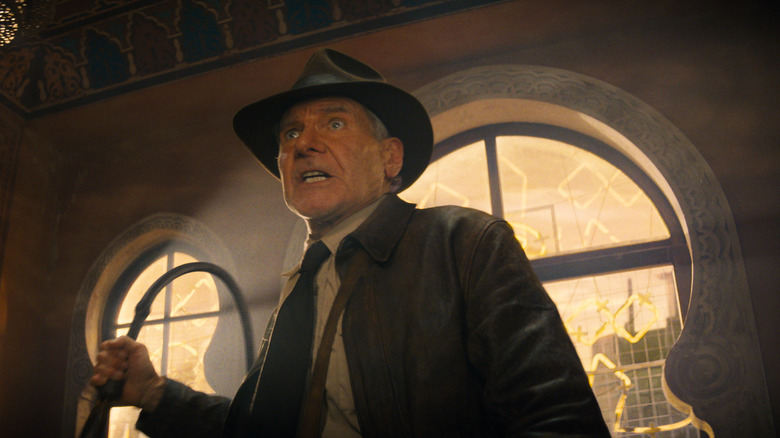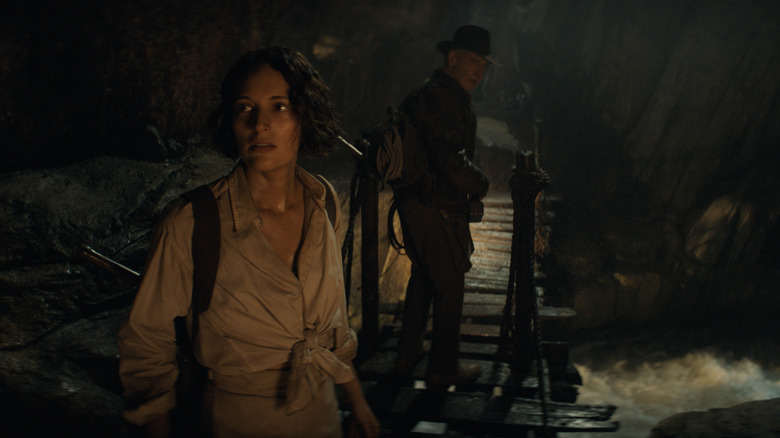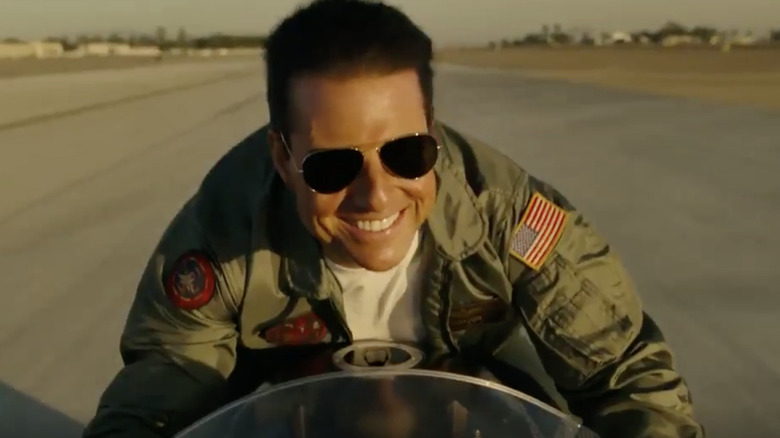Indiana Jones And The Dial Of Destiny Shares An Ending With Another Major Blockbuster
Major spoilers for "Indiana Jones and the Dial of Destiny" to follow.
Indiana Jones is getting older, there's no way around that — regardless of any de-aging technology that tries and fails to give us young Harrison Ford (static shots look great, but any movement ruins the illusion). Though "Indiana Jones and the Kingdom of the Crystal Skull" also dealt with an older Dr. Henry Jones Jr., it didn't really focus too much on the archeologist's age.
That's not the case with "Indiana Jones And The Dial Of Destiny," the latest and seemingly last hurrah for the famed archeologist and definitely not graverobber. This fun and old-school adventure movie sees Harrison Ford's Indiana team up with his goddaughter Helena Shaw (Phoebe Waller-Bridge) in a race against time to prevent Nazis from getting their hands on an ancient artifact (yes, again ... if it ain't broke).
This film does have Indiana's age front and center, informing everything about the character and the plot. Indiana is a man with regrets, with loss, and the film treats that with more impact than "Kingdom of the Crystal Skull." He's a man out of time, like the Nazi he's trying to evade. The dynamic between Helena and Indy is nothing like that between Indiana and his son Mutt in the previous film, as Helena is not a clear copy of Indy nor a replacement, but someone with their own troubled past who learns to care about the old man as a link to the past.
This culminates in a truly wild third act that's perhaps the most fantastical the franchise has ever got, but also an ending that "Indiana Jones And The Dial Of Destiny" shares with another recent blockbuster about an old man searching for relevance in a changed world — "Top Gun: Maverick."
Man out of time
The third act of "Dial of Destiny" involves Indiana, Helena, and the Nazis traveling back in time to the siege of Syracuse in the third century BC, where the plane they arrive in gets shot down by Roman forces. With one plane left, and limited time to get out or get trapped in ancient Greece forever, Indiana offers himself up as a sacrifice. Having been shot earlier (in the shoulder, not fatally), Indy decides he'd prefer to take the opportunity to live his remaining days in the past he's spent a lifetime studying.
This is a moment many a fan thought would happen going into "Dial of Destiny," that Harrison Ford would only agree to the movie if he got another Han Solo moment and die immediately after coming back. This makes sense according to legacy sequel rules, you use the older characters to pass the torch — but "Indiana Jones and the Dial of Destiny" has other things in mind.
Right as Indiana is having a meaningful conversation with the real Archimedes and preparing to die of infection in Ancient Greece, Helena sucker-punches him and puts him on the plane, ruining his plan but saving his life. This is quite similar to "Top Gun: Maverick," another legacy sequel about an old man struggling to find his place in a changing world, who leads a group of younger potential replacements. Going into that film, there was almost no chance Maverick would survive to the end, and with good reason. Maverick spends most of the film being called a ghost, a specter of a dying era. During the final mission, he easily sacrifices himself to save his replacement and achieve redemption by saving his best friend's son, Rooster.
A second chance at life
"Top Gun: Maverick" doesn't kill its titular character, however, because Rooster risks his own life to save Maverick, and the two make it home safe. In a rare move for a legacy sequel, the old guard doesn't die, nor does it pass the torch, but they save the day and live to tell the tale.
Legacy sequels are an easy sell to both audiences and executives. You get to see iconic characters return for another hurrah, driving ticket sales due to nostalgia, but you also build up a new cast of characters to carry the franchise forward in new installments (usually after the originals die). We had this with "Tron: Legacy," the "Star Wars" sequel trilogy, "Scream" and more. What makes the new "Indiana Jones" and "Top Gun: Maverick" work surprisingly well is that they are not concerned with teasing a future for their franchises (unlike "Kingdom of the Crystal Skull"). What they are interested in is giving its aging stars one last victory before saying goodbye to the characters, not in death, but in some well-earned retirements.


